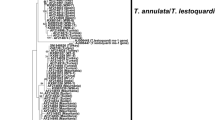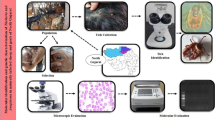Abstract
Ovine theileriosis is an important hemoprotozoal disease of sheep and goats in tropical and subtropical regions which caused high economic loses in the livestock industry. Theileria annulata surface protein (TaSp) was used previously as a tool for serological analysis in livestock. Since the amino acid sequences of TaSp is, at least, in part very conserved in T. annulata, Theileria lestoquardi and Theileria china I and II, it is very important to determine the amino acid sequence of this protein in Theileria ovis as well, to avoid false interpretation of serological data based on this protein in small animal. In the present study, the nucleotide sequence and amino acid sequence of T. ovis surface protein (ToSp) were determined. The comparison of the nucleotide sequence of ToSp showed 96, 96, 99, and 86 % homology to the corresponding nucleotide sequence of TaSp genes by T. annulata, T. China I, T. China II and T. lestoquardi, previously registered in GenBank under accession nos. AJ316260.1, AY274329.1, DQ120058.1, and EF092924.1 respectively. The amino acid sequence analysis showed 95, 81, 98 and 70 % homology to the corresponding amino acid sequence of T. annulata, T chinaI, T china II and T. lestoquardi, registered in GenBank under accession nos. CAC87478.1, AAP36993.1, AAZ30365.1 and AAP36999.11, respectively. Interestingly, in contrast to the C terminus, a significant difference in amino acid sequence in the N teminus of the ToSp protein could be determined compared to the other known corresponding TaSp sequences, which make this region attractive for designing of a suitable tool for serological diagnosis.


Similar content being viewed by others
References
Ahmed JS, Luo J, Schnittger L, Seitzer U, Jongejan F, Yin H (2006) Phylogenetic position of small-ruminant infecting piroplasms. Ann NY AcadSci 108:498–504
Bakheit MA, Schnittger L, Salih DA, Boguslawski K, Beyer D, Fadl M, Ahmed JS (2004) Application of the recombinant Theileria annulata surface protein in an indirect ELISA for the diagnosis of tropical theileriosis. Parasitol Res 92:299–302
Gubbels JM, d’Oliveira C, Jongejan F (2000) Development of an indirect Tams1 enzyme-linked immunosorbent assay for diagnosis of T. annulata infection in cattle. Clin Diag Lab Immunol 73:404–411
Hashemi-Fesharaki R (1997) Tick-borne diseases of sheep and goats and their related vectors in Iran. Parasitologia 39:115–117
Hooshmand-Rad P, Hawa NJ (1973) Malignant theileriosis of sheep and goats. Trop Anim Health Prod 5:97–102
Inci A, Ica A, Yildirim A, Duzlu O (2010) Identification of Babesia and Theileria species in small ruminants in Central Anatolia (Turkey) via reverse line blotting. Turk J Vet Anim Sci 34:205–210
Jalali SM, Khaki Z, Kazemi B, Rahbari S, Shayan P, Bandehpour M, Yasini SP (2014) Molecular detection and identification of Theileria species by PCR-RFLP Method in sheep from Ahvaz, Southern Iran. Iranian J Parasito l9:99–106
Leemans I, Hooshmand-Rad P, Uggla A (1997) The indirect fluorescent antibody test based on schizont antigen for study of the sheep parasite Theileria lestoquardi. Vet Parasitol. 69(1-2):9–18
Mansour H (2010) Serological survey of Theileria lestoquardi in some regions of Iran. Dissertation, University of Tehran
Nagore D, GarcIa-Sanmartin J, GarcIa-Pérez AL, Juste RA, Hurtado A (2004) Identification, genetic diversity and prevalence of Theileria and Babesia species in a sheep population from Northern Spain. Int J Parasitol 34:1059–1067
Niu Q, Luo J, Guan G, Ma M, Liu Z, Liu A, Dang Z, Gao J, Ren Q, Li Y, Liu J, Yin H (2009) Detection and differentiation of ovine Theileria and Babesia by reverse line blotting in China. Parasitol Res 104:1417–1423
Ranjbar-Bahadori S, Eckert B, Omidian Z, Sadr Shirazi N, Shayan P (2012) Babesia ovis as the main causative agent of sheep babesiosis in Iran. Parasitol Res 110:1531–1536
Sadr-Shirazi N, Shayan P, Eckert B, Ebrahimzadeh E, Amininia N (2012) Cloning, and molecular characterization of polymorphic Iranian isolate Theileria annulata surface protein (Tasp). Iranian J Parasitol 7:29–39
Salih DA, Ahmed JS, Bakheit MA, Ali EB, El Hussein AM, Hassan SM, Shariff OE, Fadl M, Jonge-jan F (2005) Validation of the indirect TaSp Enzyme linked immunosorbent assay for diagnosis of T. annulata infection in cattle. Parasitol Res 97:302–308
Schneider I, Haller D, Kullmann B, Beyer D, Ahmed J, Seitzer U (2007) Identification, molecular characterization and subcellular localization of a T. annulata parasite protein secreted into the host cell cytoplasm. Parasitol Res 101:1471–1482
Schneider I, Haller D, Seitzer U, Beyer D, Ahmed J (2004) Molecular genetic characterization and subcellular localization of a putative T. annulata membrane protein. Parasitol Res 94:405–415
Seitzer U, Beyer D, Kullmann B, Bakheit MA, Ahmed JS (2008) Evaluation of T. annulata Recombinant Immuno dominant Proteins for the Development of ELISA. Transbound Emerg Dis 55:244–248
Seitzer U, Mohammed A, Bakheit MA, DiaEldin A, Salih DA, Awadia A, Haller D, Yi H, Schnittger L, Ahmed J (2007) From molecule to diagnostic tool: T. annulata suface protein TaSp. Parasitol Res 101:217–223
Shayan P, Ebrahimzadeh E, Tageldin MH, Amininia N, Eckert B (2011) Molecular study of sheep malignant theileriosis at Barka Region in the sultanate of Oman. Iranian J Parasitol 6:66–72
Shayan P, Nabian S (2008) The use of immune staining for determination of Babesia and Theileria and gene expression of proliferation associated with nuclear protein in Theileria infected cells. Iranian Veterinary Journal 3:21–29, PERSIAN
Shayan P, Rahbari S (2005) Simultaneous differentiation between Theileria spp. and Babesia spp. On stained blood smear using PCR. Parasitol Res 97:281–286
Zaeemi M, Haddadzadeh HR, Khazraiinia P, Kazemi B, Bandehpour M (2011) Identification of different Theileria species (Theileria lestoquardi, Theileria ovis, and Theileria annulata) in naturally infected sheep using nested PCR–RFLP. Parasitol Res 108:837–843
Acknowledgments
We thank the Iranian Higher Council of Sciences, Research and Technology and Central Excellence for Immunophatology of Iran for the financial support.
Author information
Authors and Affiliations
Corresponding author
Rights and permissions
About this article
Cite this article
Shayan, P., Jafari, S., Fattahi, R. et al. Identification and characterization of Theileria ovis surface protein (ToSp) resembled TaSp in Theileria annulata . Parasitol Res 115, 1893–1899 (2016). https://doi.org/10.1007/s00436-016-4929-1
Received:
Accepted:
Published:
Issue Date:
DOI: https://doi.org/10.1007/s00436-016-4929-1




